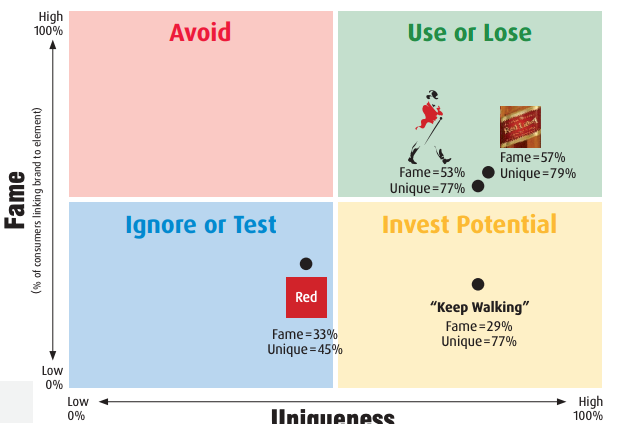6 Rules for Building Brand

First published in 2010 and revised in 2014, Byron Sharp's How Brands Grow is a crucial book for marketers. It's based on decades of research that are consistent in their findings about buying and brand performance; findings Sharp calls the "laws" of marketing because they are consistent across industries, across price points, and across time. The book presents these laws in context, and explores their meaning and marketing applications.
The central idea is to make a brand easy to buy by
- ensuring mental availability: build connections between the brand and a category when a person is not actively buying
- ensuring physical availability: ensuring the product is easy to find and investigate when a person is actively buying
Most people, most of the time, aren't buying in whatever category you're selling. Your job as a marketer is to build "mental availability" – connections between your brand and the category in a consumer's mind. Now, when the person does engage with a category, the connection with your brand is established.
The evidence for this is the strong correlation between share of voice and market share. Share of voice (the amount of media spending for a product vs the total media spend for the category) has been established as correlated with market share across every product imaginable; from consumer goods, to banking, to commodities like grain and steel.
The book is written for a general audience, and much of the examples and insights are related to customer goods. However, it's a mistake to think that B2B marketing is an entirely different beast. It absolutely is not. All of Sharp's laws are applicable B2B, with the caveat that B2B marketers have to extend their strategy beyond Sharp's book. Sharp ends at the purchase decision, which is different for toothpaste than it is for, say, an enterprise security solution.
The way I think of it is that Sharp's laws are related to branding and top-of-funnel campaigns in B2B. This is important because so many B2B companies get this wrong, using the same rational argument techniques for branding campaigns as they do in their product marketing. (Using purely rational arguments in your product marketing is also a mistake. There are few purchase decisions as emotionally rife as a B2B. Making a bad decision around toothpaste will not likely cause you to lose your job, but making a bad database recommendation certainly could. This is a topic for another post.)
Here, then are Sharp's laws of marketing. For B2B, think of them as laws of branding and awareness.
Law 1: Refresh and build associations
The purpose of advertising is to construct and refresh memory structures. Memory structures are connections in the mind between the brand and the brand's message. For example, Coca-Cola wants to build and reinforce a connection between Coke and fun times in people's lives, like when everyone was out having a great time at a BBQ with their family. Microsoft wants to build a connection between Office and productivity.
Memory structures must exist in a consumer's head, or they will not notice your brand. Practical advice for marketers is to consider existing associations you can use and reinforce with your brand.
Law 2: Avoid being silent
No brand, even the largest and most established brands, can afford to be silent. Memory structures strengthen with reinforcement and weaken with silence. People's minds are busy, and information fades quickly if it's not reinforced. (Think about the times you crammed for a test and how well you remember the subject one week after the test.)
As time passes and people change, brands must constantly reinforce mental associations. Even well-established brands like Coca-Cola must do this, so they regularly update their advertisements.
Practical advice for smaller B2B advertisers: If you have a small budget, consider using it on an ABM strategy to reach target buyers more often.
Law 3: Make sure you get noticed
For marketing to work, it needs to be noticed, processed, and linked to the correct brand. Many companies instead focus on differentiation, explaining why their product is different (and better) than the competition. However, this can be a wasted effort unless the consumer actively researches the category.
A key message from Sharp is that salience—how prominent or noticeable something is—is more important than differentiation, at least at the top of the funnel. At this stage, it matters most that you build the mental connection between the brand and the category.
Practical advice is that when creating your brand, you have to figure out how to get it noticed among the competition. How can you stand out in a crowded market? What is distinctive about your assets?
Law 4: Create and use distinctive brand assets
You can spend a lot of time, energy, and money building a mental association between a message and a brand. But if the assets aren't distinctive to your brand, your efforts will be ineffective,.
And "distinctive" doesn't (only) mean distinct in the sense that it's easier to see, like brighter colors. It means distinct in the sense that it's associated with your brand, and your brand only. Otherwise, you'll dilute the connection. One way to measure this is to research brand assets in terms of fame (how often the assets is associated with any brand), and uniqueness (how strongly the asset is associated with your brand). Consider this research on the Johnnie Walker Red Whiskey brand assets:

We see two assets the company should reinforce and protect: the distinctive label and the walking man. Other assets tested didn't fare as well, such as the color red. Most people didn't associate red with any brand, and of those that did associate the color with a brand, it wasn't particularly unique to Johnnie Walker. Finally,, and money building a mental association between a message and a brand. But if the assets aren't distinctive to your brand, your efforts will be ineffective we see the asset "keep walking," which wasn't well known but was strongly associated with the brand. Efforts to promote this asset could make it better known and a stronger advocate for the brand.
Practical advice is to research your brand's distinctive assets – ,assets that consumers associate with your brand and with nothing else. Then you need to use and protect these.
Law 5: Be consistent
Sharp points out that consistency in brand identity is something that many brand strategies lack, particularly across campaigns. For example, when a new campaign is created, most of the attention is placed on what is new and fresh. More attention should be placed on making sure the branding elements are similar and consistent; someone who saw the last marketing campaign should understand that the new campaign comes from the same brand.
Proponents of integrated marketing campaigns have emphasized the importance of consistency, but it's a mistake to embrace the idea of consistency across media but not consistency across , too, that the objective is to create mental associations before the consumer is actively buying. At this stage, don't emphasize consistency in the brand’s message and positioning rather than in.
Remember, too, that the objective is to create mental associations before the consumer is actively buying. At this stage, don't emphasize consistency in the brand’s message and positioning rather than inyour brand's distinctive assets the visual, verbal or style of branding elements. It is only when there is discipline in this consistency that distinctive brand assets build.
Law 6: Stay competitive
This is where the rubber hits the road regarding your efforts to build mental associations for your brand. Your brand must be available when a person enters a category and are interested in buying. This can mean that it is physically available, such as a brand of toothpaste that must be sitting on a shelf. It can also mean digitally available, such as findable in Google SERPs.
For most technical enterprise B2B, availability goes beyond being found in SERPs. This is when product marketing comes into play – we've captured the consumer's attention, now we need to take advantage of it by removing obstacles, explaining features, encouraging trials, and addressing concerns about pricing, support, or longevity.
More reading
A great reference for the interplay between long term (awareness/association-building) campaigns and short term (availability/product) campaigns is Les Binet's and Peter Field's The Long and the Short of It, which provides research based suggestions on how to balance investment in these two marketing objectives.
